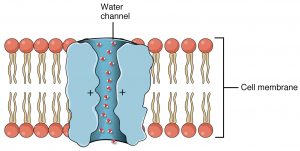As the Earth’s population grows, there is a parallel increase in demand for clean, potable water.
The ability to effectively and efficiently filter water is a problem that many researchers and scientists are trying to solve. Water clean enough for human consumption is free of undesirable chemicals, biological contaminants, and harmful gasses.
To address this growing issue, researchers have been exploring the applications of carbon nanotubes. Analogous to aquaporins, proteins in cells that transport water, these nanotubes are synthetically created to have a higher efficiency of water transport and selectivity for ions and molecules.

Aquaporins: Biological water transporter located in the cell membrane. What researchers are trying to replicate.
The structural feature responsible for the successful transport of water in aquaporins is the narrow, hydrophobic (water fearing) channel which forces water to translocate in a single-file arrangement. Past studies have tried to mimic this structure using a >1 nm diameter, but failed to replicate the effectiveness of aquaporins.
However, new studies done by Tunuguntla et al. have proven that it is possible to create artificial water channels with increased productivity to the natural protein translocator. They have created carbon nanotubes with diameters approximately 0.8 nm wide. The new nanotube models showed water flux at a rate 6 times higher than aquaporins.
In addition, their experimentation showed a very high ion selectivity. In solutions with a very high salt concentration (NaCl), the nanotubes were still able to transport water. This finding is very promising for the desalination of water. In areas were fresh water is unavailable, application of carbon nanotubes in water purification systems would prove immensely beneficial to communities facing water scarcity.
These findings are especially promising because scientists have created an artificial water channel that rivals biological equivalent.
-Mya Dodd

